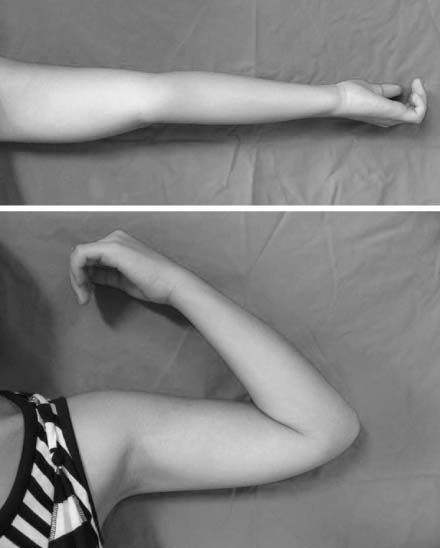J Korean Fract Soc.
2008 Apr;21(2):130-134. 10.12671/jkfs.2008.21.2.130.
Double Tension Band Wiring for Olecranon Fractures
- Affiliations
-
- 1Department of Orthopaedic Surgery, College of Medicine, Dongguk University, Gyeongju, Korea. kjpil@dongguk.ac.kr
- KMID: 2183908
- DOI: http://doi.org/10.12671/jkfs.2008.21.2.130
Abstract
-
PURPOSE: To evaluate the clinical results of double tension band wiring for communited olecranon fractures involving proximal 1/3.
MATERIALS AND METHODS
We reviewed 9 cases of communited olecranon fractures involving proximal 1/3 treated with double tension band wiring followed for minimum 10 months. There were 2 cases of olecranon fractures involving only proximal 1/3, 6 cases of olecranon fractures involving from proximal 1/3 to middle 1/3 and 1 case of olecranon fractures involving from proximal 1/3 to distal 1/3. We analyzed the bone union time, radiologic results for gap, reduction loss, pin migration, pain, range of motion, complications and functional outcomes at last follow up.
RESULTS
All patients had solid bone union without additional surgery and average union time was 10.3 weeks. Anatomical reduction could be obtained in 8 of 9 cases but there was 1 mm step off in one case. 36 pins were used to fix the fractures, 1 pin of 18 distal pins and 2 pins of 18 proximal pins were migrated to backward but there was no reduction loss. Only 1 distal pin needed early removal due to skin irritation. Average range of motion ranged from flexion contracture 3.3 degrees to further flexion 137.8 degrees. On functional analysis, we got 8 cases of good result, 1 case of fair result and there was no poor result.
CONCLUSION
Double tension band wiring for comminuted olecranon fracture involving proximal 1/3 was concluded to give a firm fixation of the fracture site as bone union could be acquired without serious pin problems.
Figure
Cited by 2 articles
-
Olecranon Nonunion after Operative Treatment of Fracture
Ho-Jung Kang, Ji-Sup Kim, Myung-Ho Shin, Il-Hyun Koh, Yun-Rak Choi
J Korean Fract Soc. 2015;28(1):30-37. doi: 10.12671/jkfs.2015.28.1.30.Treatment of Olecranon Fractures with Proximal Ulna Comminution Using Locking Compression Plates
Ki-Do Hong, Tae-Ho Kim, Jae-Cheon Sim, Sung-Sik Ha, Min-Chul Sung, Jong-Hyun Jeon
J Korean Fract Soc. 2015;28(1):59-64. doi: 10.12671/jkfs.2015.28.1.59.
Reference
-
1. Coonrad RW. The elbow. Master techniques in orthopaedic surgery. In : Morrey BF, editor. Management of olecranon fractures and nonunion. 1st ed. New York: Raven Press Ltd;1994. p. 71–95.2. Fyte IS, Mossad MM, Holdsworth BJ. Methods of fixation of olecranon fractures. An experimental mechanical study. J Bone Joint Surg Br. 1985; 67:367–372.3. Helm RH, Hornby R, Miller SW. The complications of surgical treatment of displaced fracture of the olecranon. Injury. 1987; 18:48–50.
Article4. Macko D, Szabo RM. Complications of tension-band wiring of olecranon fractures. J Bone Joint Surg Am. 1985; 69:1396–1401.
Article5. Matter P, Scharplatz D. Fractures and dislocation of the Elbow. Operative orthopedics. 2nd ed. Philadelphia: J.B. Lippincott Co;1988. p. 253–262.6. Morrey BF. Current concepts in the treatment of fractures of the radial head, the olecranon and the coronoid. Instr Course Lect. 1995; 44:175–185.
Article7. Muller ME, Allgower M, Schneider R, Willenegger H. Manual of internal fixation. 3rd ed. Berlin: Springer-Verlag;1991. p. 44–45.8. Park SW, Hur CY, Shim JH. Operative treatment of olecranon fracture. J Korean Soc Fract. 1994; 7:58–64.
Article9. Shin HD, Rhee KJ, Lee JK, et al. Operative treatment of olecranon fractures using tension band wiring. J Korean Soc Fract. 1998; 11:672–682.
Article10. Weber BG, Vasey H. Osteosynthesis bin olekranon fraktures. Z Unfallmed Berufskr. 1963; 56:90–96.
- Full Text Links
- Actions
-
Cited
- CITED
-
- Close
- Share
- Similar articles
-
- The Clinical Results of Tension Band Wiring
- Tension Wiring in the Treatment of the Olecranon, Patella and Malleolar Fracture
- The Effect of Tension Band Wiring in the Treatment of the Olecranon Fracture
- Tension band wiring and Modified tension band wiring in the Operative Treatment of Patella Fracture
- Fractures of the Olecranon of Ulna treated by Plating and Tension-Band Wiring technique




